The year 1066 AD is a year everyone in Western civilization should know. The following short summary of the history would not pass a PhD scrutiny, but it gives a researched view into a significant historical event. Hopefully it will provide some insight for us who are the long-term heirs of this watershed moment in history.
The Norman Invasion
In 1066, William the Conqueror sailed across the English Channel with 7000 warriors from Normandy in Northern France and invaded England. The English and 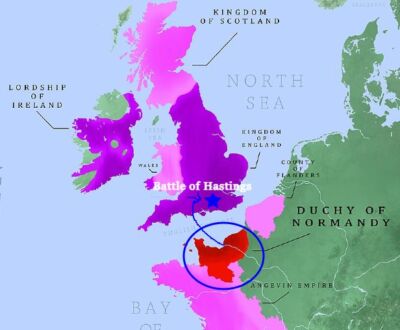 French fought the Battle of Hastings on October 14th of that year and the French decisively vanquished the English who were still a tribe of Anglo-Saxons at the time.
French fought the Battle of Hastings on October 14th of that year and the French decisively vanquished the English who were still a tribe of Anglo-Saxons at the time.
The English language of Chaucer wouldn’t exist for another 300 years. For that matter, the Normans were barely out of their Viking period (their name derived from what the natives called them: the Norse- or North-men).
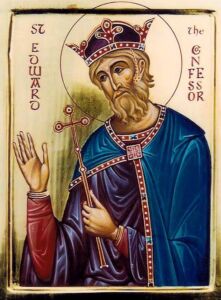 The reason for the battle was that the saintly Anglo-Saxon King, Edward the Confessor, was childless and wanted his French cousin, William, Duke of Normandy, to succeed him to the throne. However, Edward’s devious assistant, Harold Godwinson, had other ideas and proclaimed himself King upon Edward’s death. Men named Harry seem to be problematic in English history.
The reason for the battle was that the saintly Anglo-Saxon King, Edward the Confessor, was childless and wanted his French cousin, William, Duke of Normandy, to succeed him to the throne. However, Edward’s devious assistant, Harold Godwinson, had other ideas and proclaimed himself King upon Edward’s death. Men named Harry seem to be problematic in English history.
Well, as you might imagine, William wasn’t happy at being usurped and decided to take drastic action to claim his rightful throne. The subsequent invasion is what history knows as the Norman Conquest. In the end, the wicked King Harold died by an arrow through the eye at the Battle of Hastings, and everyone believed that divine justice had been rightfully served.
Returning the Favor
Everyone except the English, of course, who never forgave the French for their uppity transgression, and decided to return the favor by invading France some three hundred years later (1337 AD), just about the time Chaucer was getting started. What works for the goose, works for the gander apparently.
This time, however, the English claimed that they had some right to the French throne because all the English kings from William the Conqueror onward had 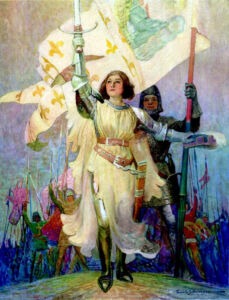 Norman/French blood. It was probably a better pretext for an invasion than the illusory “weapons of mass destruction” excuse, if you ask me. There were also some other issues about stolen territory, etc. that the nobility are always squabbling about.
Norman/French blood. It was probably a better pretext for an invasion than the illusory “weapons of mass destruction” excuse, if you ask me. There were also some other issues about stolen territory, etc. that the nobility are always squabbling about.
Anyway, the English invasion of France in 1337 began what was known as the Hundred Years War, which actually lasted for 116 years, but no historian ever wanted to label it the Hundred-And-Sixteen-Years War, for obvious reasons.
And that war gave us Joan of Arc in 1429-1431, my favorite saint. To me, that’s the end of the story and reason enough to know the history!
But, as much as I’d like to talk about Joan of Arc, I’ll have to stick to my subject, the Battle of Hastings, and the way in which the conquerors commemorated the victory. You might be surprised. They created a majestic hand-woven tapestry with scenes of the battle, and it’s a masterpiece.

The Bayeux Tapestry
This is the precious artifact known today as the Bayeux Tapestry (pron. bayou), which experts and random seamstresses alike will tell you is not actually a tapestry. A tapestry is a weaving where designs are created within the very weave of the fabric.
The Bayeux “tapestry”, in contrast, is an elaborate embroidery stitched onto nine panels of linen that stretches a whopping 224 feet in length. I’ll get to the details of it below, but first a word about its creation.
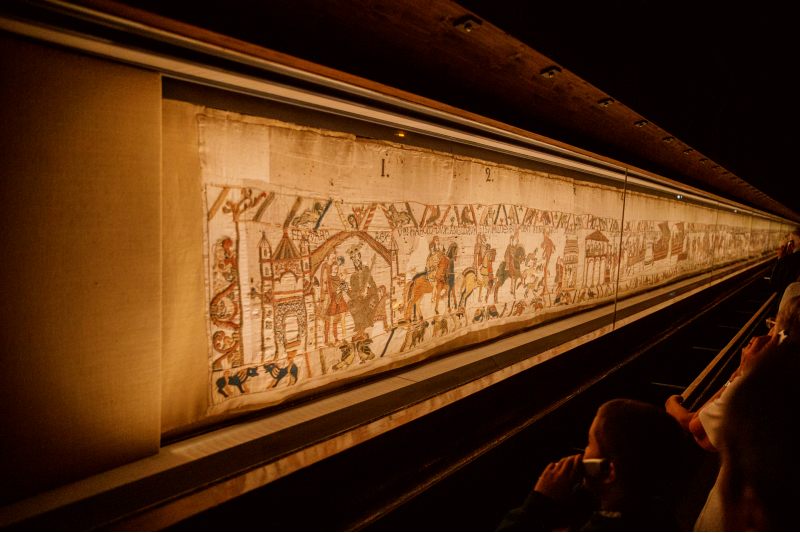
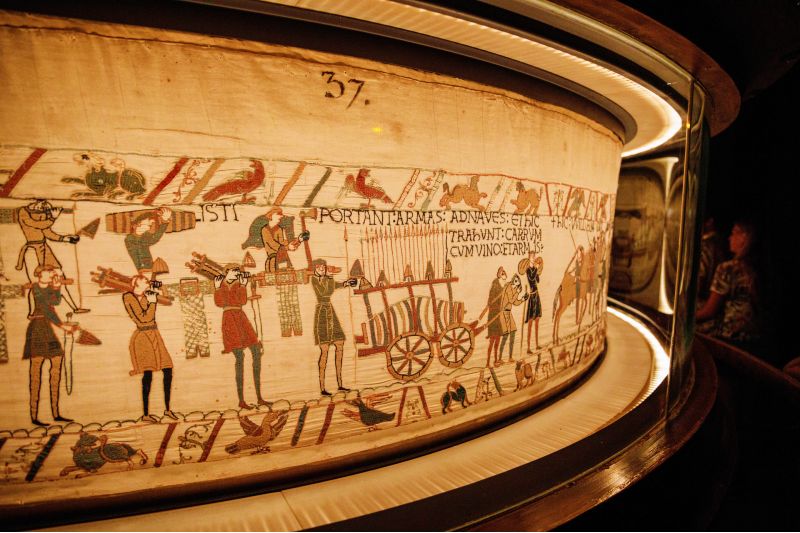
The Bayeux Tapestry on display in the Bayeux Museum in Normandy, France
The Patron of the Project
Anyway, the next and more likely theory is that Odo, the Bishop of Bayeux, had the tapestry made to decorate the cathedral he was building at that time. 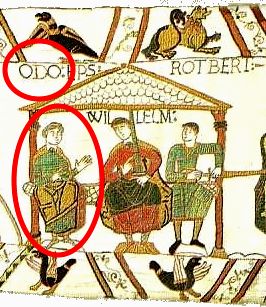 Unsurprisingly, Bayeaux is located in Normandy where William the Conqueror came from, and Odo just happened to be William’s half-brother from the French side of the clan.
Unsurprisingly, Bayeaux is located in Normandy where William the Conqueror came from, and Odo just happened to be William’s half-brother from the French side of the clan.
Odo was not shy either: he had an image of himself woven into the tapestry, next to William. Kind of like the medieval version of a selfie. Pretty clever.
If Odo sought to ingratiate himself with the new king, a massive piece of war propaganda celebrating his famous sibling’s victory was a good way to do it. Odo was also a major player in the war, so he had first-hand experience of what happened there.
I’m told that the Pope of the day was a big fan of William and allegedly had no problem with reams of political messaging hanging all over the walls of a Catholic cathedral. My, how times have changed.
In any case, Odo’s cathedral was consecrated in 1077, so the tapestry was probably created somewhere in the decade of the 1070s and no one knows if King William ever saw it. However, Odo lived for 20 more years, so he had plenty of time to tell the story and send drawings across the channel to his half-brother. As I said, he wasn’t shy.
Facts About This Masterpiece
The Bayeux Tapestry is a massive work of art, and even though it depicts a secular and rather bloody event, it’s also a kind of sacred window into human talent.
God is the author of all natural gifts, so the proper use of artistic talent for the sake of beautifying the world gives glory to the Giver of the gifts, Who also beautified our world wonderfully. Artistic talent, in some way, reflects His divine artistry of the world.
Certain basic facts show the monumental nature of this creation. I’ve already mentioned that is stretches 224 feet in 9 separate linen panels woven together to tell one massive story. It also has:
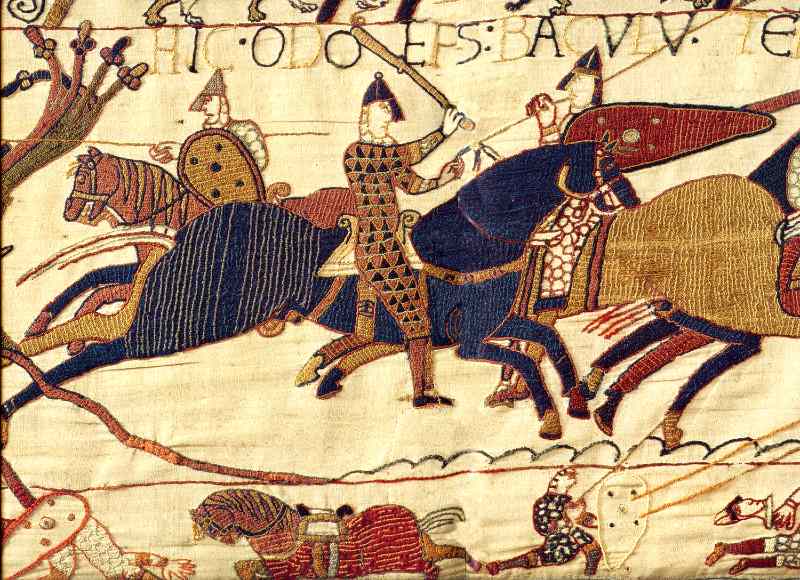
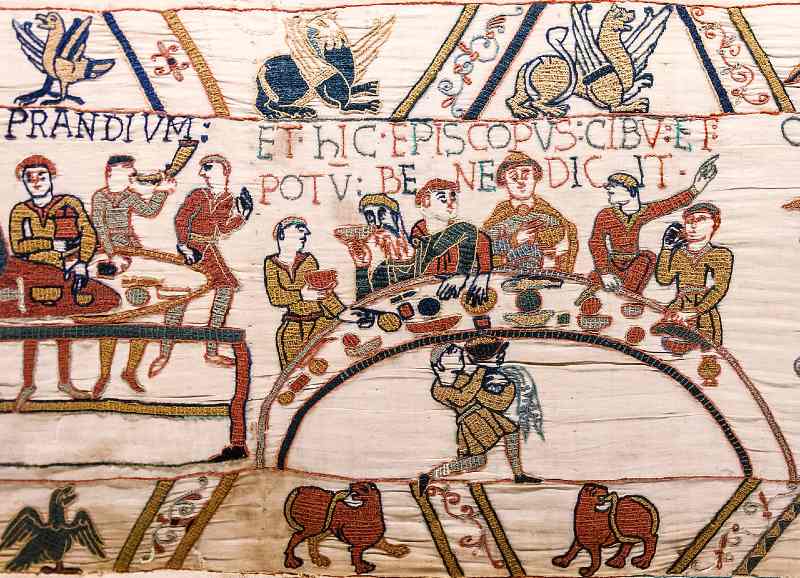
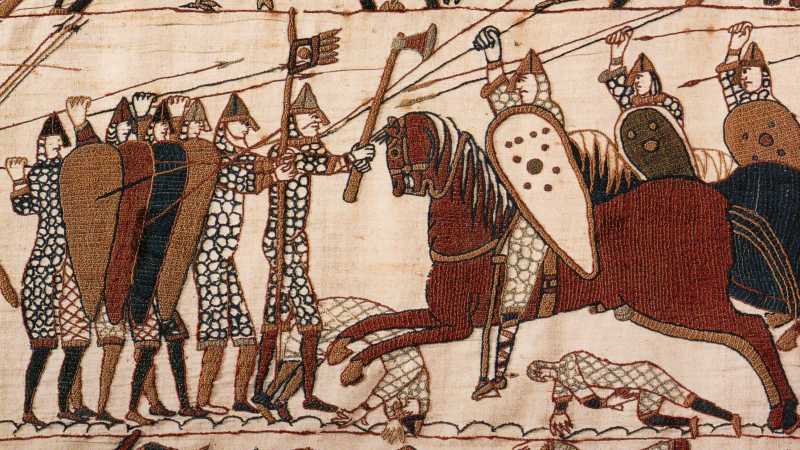
- A width of 20 inches with top and bottom borders of 3 inches, leaving 14 inches for the stitchings of the main narrative in the center.
- Border imagery of beasts and mythological figures that anticipate by 100 years the gargoyles of the glorious French cathedrals.
- 10 different colors of dyed woolen thread.
- 58 separate scenes (each is numbered above the scene on the tapestry).
- At least two panels that are missing from the far end of the tapestry which would have added another 20 feet to the length. They probably depicted William’s coronation.
- 626 distinct human, animal, and fictitious characters. 19 of the human actors are identified by name on the tapestry.
- 202 horses, although there were as many as 2000 horses involved in actual battle.
- Latin inscriptions running the length of the tapestry describing the scenes for those who could read.
As that last point indicates, the tapestry is essentially a large pictogram or illustrated storybook which was used to explain the world-changing French victory to the vast populace of illiterate French peasants and pilgrims from all over Europe.
Endless Fascination
The Wikipedia entry quotes one of the conservators of the tapestry who had this to say about its significance as a cultural artifact:
The Bayeux tapestry is one of the supreme achievements of the Norman Romanesque [style]…. Its survival almost intact over nine centuries is little short of miraculous … Its exceptional length, the harmony and freshness of its colours, its exquisite workmanship, and the genius of its guiding spirit combine to make it endlessly fascinating.
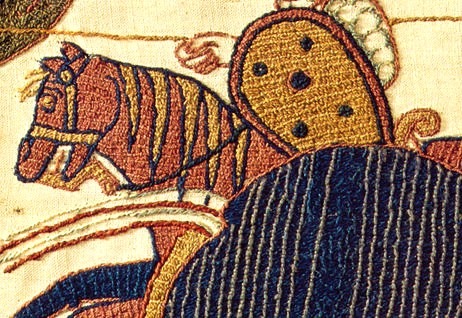
Detail of the Stitching
Fascinating is right. You can actually scroll through the entire 224 feet of the tapestry online at the official website of the Bayeux Museum. The Norman Invasion begins at Panel 35 with the building of ships to cross the Channel:
And this other resource provides a scene-by-scene translations of the Latin inscriptions with images of each of the panels:
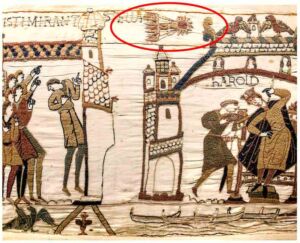 Oh, and by the way, Haley’s Comet lit up the sky in April 1066, just a few months after Harold’s (self-) coronation. It was considered to be a bad omen for the new king. They didn’t realize how accurate Haley’s prognostication would be.
Oh, and by the way, Haley’s Comet lit up the sky in April 1066, just a few months after Harold’s (self-) coronation. It was considered to be a bad omen for the new king. They didn’t realize how accurate Haley’s prognostication would be.
The embroiderers included an image of it in scene 32 which is believed to be the earliest known depiction of the comet. Wow!
Incredible Endurance
The conservator who I quoted above has a point about the tapestry’s survival skills. This flimsy piece of linen, as large as it might be, is still just a cloth, but it has defied all possibilities of destruction through water, fire, war, and human wickedness for more than nine centuries.
Just to name a few of its most perilous death-defying moments:
- It survived the ravages of the French Revolution (1792) where it was confiscated by the radicals and used to cover a military wagon (!) A conscientious lawyer absconded with it and kept it in his house until after the Reign of Terror passed.
- In 1803 Napoleon used it as a piece of war propaganda in preparation for his plan to invade England (in imitation of his hero William the Conqueror), but he changed his mind and the piece was returned to Bayeux.
- It survived the Franco-Prussian War in 1870 by being once again placed in special storage.
- In 1944, during the German occupation of France, it barely escaped Heinrich Himmler’s plan to steal it and make off to Berlin with it. By that time, however, the French had already reconquered Paris and saved it. Himmler thought the tapestry showed the glory of the German nation (head scratch, don’t try to figure that one out.)
Such a fragile artifact has also proven to have incredible endurance through nearly a thousand years of human history. Another wow.

Message
If I were to try to derive one overall lesson of the Bayeux Tapestry, it would be this: beauty inspires, beauty uplifts, beauty endures.
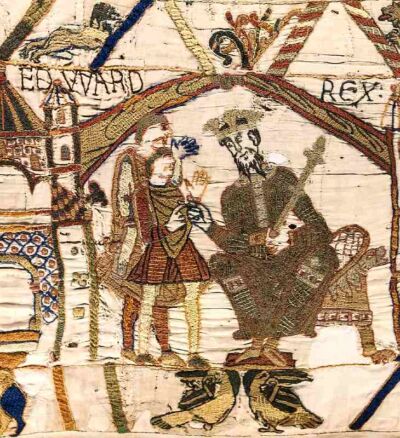 Beauty is not just in the eye of the beholder but has an objective character—we know it when we see it. That applies to human skill and the works of human intelligence as well.
Beauty is not just in the eye of the beholder but has an objective character—we know it when we see it. That applies to human skill and the works of human intelligence as well.
This message is more vital today than ever before because in modern society, the creation of beauty is rapidly being stamped out and replaced by robotic ugliness everywhere we look.
The human talents required to create a magnificent work of art like the Bayeux tapestry are also diminishing, not to mention the social/religious environments where these talents are nurtured and perfected.
Every effort to create beauty makes our world a better place, even if it means simple efforts to beautify home and workplace. All beauty reflects the greater Beauty of the supernatural world. Look around today and see how your human talents can add some value to the world and glorify the work of the great Artist Himself.
———-
[Note: This article is a reproduction of the Sacred Windows Email Newsletter of 10/19/25. Please visit our Newsletter Archives.]
Photo credits: Images of Tapestry Public Domain Via Wikimedia (Bayeux Tapestry); Icon St Edward the Confessor (Aidan Hart); Bayeux Museum Display @Shutterstock; Norman Conquest Map (Martianman64); Joan of Arc (Artist: Frank Schoonover).
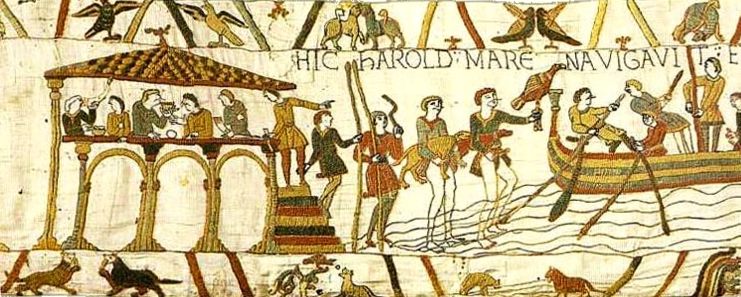


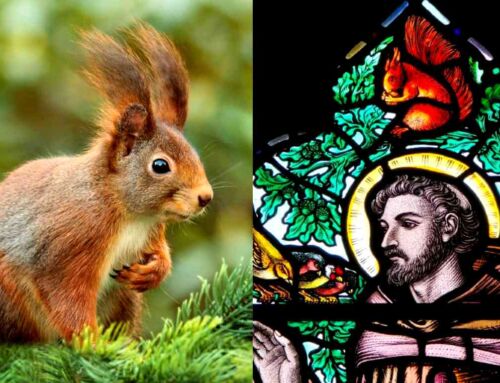
Leave A Comment